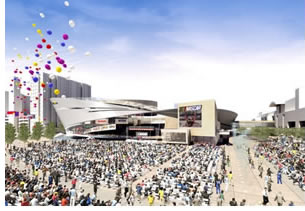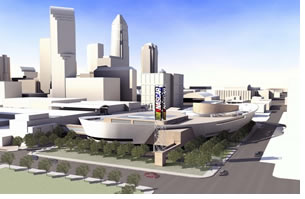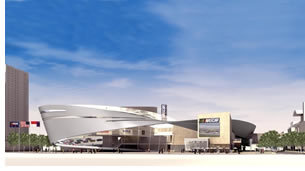

5/2006
Pei Cobb Freed’s design captures “the concept of frozen speed”

by Russell Boniface
Have you ever heard these expressions?
“The car has gone tight.”
“It feels like this car is on jack stands.”
“Through the dog leg, the car dives to the inside.”
“Let’s take a sweep to the pits.”
If so, then you must be one of the millions of fans who make NASCAR the largest sanctioned motor sport in the U.S. If not, you are not alone. But here are important facts to get you up to speed: NASCAR has 75 million fans; NASCAR has grown to become the second most popular professional sport in terms of U.S. television behind the NFL; and NASCAR boasts its own cable network, “The Speed Channel,” where you will likely hear more esoteric exclamations like “there are a lot of dogfights out there” and “grease is cheaper than steel.”
NASCAR, which stands for the National Association for Stock Car Auto Racing, dates back to 1948. A “stock” race car was originally a factory model with no modifications. The first NASCAR “Strictly Stock” race was held at the Charlotte Speedway on June 19, 1949. The sport grew in the 1950s, mainly in the south, as car manufacturers realized the opportunity to promote sales through racing. By the mid-1960s, the vehicles were purpose-built race cars with a stock-appearing body. During the 1970s sponsorship and television coverage attracted a wider audience, and the sport has grown ever since. As with other sports, NASCAR always had star performers—or drivers—but no place to celebrate them, or the sport itself. Until now.
 Racing was built here. Racing belongs here.
Racing was built here. Racing belongs here.
NASCAR announced in March that it selected Charlotte to be the home of
its hall of fame, just days after Atlanta upped the ante in a bidding
war. Albeit hard to fathom, NASCAR is the only major sanctioned organized
sport not to have a hall of fame. The brakes were put on several times
mainly due to site destination and financial debate.
But the wait is over for NASCAR fans. The 100,000-square-foot NASCAR Hall of Fame will be located on a five-acre downtown site in Charlotte’s Center City, and the designer is Pei Cobb Freed & Partners. The building will be operated by the City of Charlotte and the Charlotte Regional Visitors Authority and sit adjacent to the Charlotte Convention Center. The total cost of the hall of fame is estimated at $150 million, with $43 million of that set aside for a banquet hall for the convention center, and ground is expected to be broken next spring. Completion is expected by 2010.
The selection of Charlotte, nicknamed the Queen City, ended a yearlong race featuring other cities that included Atlanta; Daytona Beach, Fla., where the NASCAR headquarters is located; Richmond; and Kansas City, Mo. Charlotte’s proximity to the origins and heart of the sport gave it the edge in the selection process. A second factor that gave Charlotte a leg up is many top race teams’ headquarters are based in the Charlotte region. Currently, 82 percent of NASCAR Nextel Cup teams, 72 percent of NASCAR Busch Series teams, and 55 percent of NASCAR Craftsman Truck teams call the Charlotte area home. Also, famous North Carolina racers like Dale Earnhardt Jr. own luxury condominiums in downtown Charlotte or palatial homes on nearby Lake Norman. (It certainly didn’t hurt when Earnhardt Jr., one of the sport’s most popular drivers, said Charlotte should get the hall.)
Billboards and bumper stickers distributed as part of the city’s campaign for the hall boasted “Racing was built here. Racing belongs here'' and “We Eat, Sleep and Breathe Racing.” NASCAR’s current annual economic impact in the Charlotte region is estimated to be $4 billion, as well as generating 18,000 jobs. Charlotte expects the Hall to be a boon to tourism, as NASCAR projects an annual attendance of 400,000 to visit its new hall of fame.
 A curved form
A curved form
The iconic design of the NASCAR Hall of Fame showcases a twisting, oval-shaped wrapping, evoking the shape of a speedway and representing the sport's high-speed movement. From one corner of the building, a latticework tower emblazoned with the NASCAR logo will rise, reminiscent of the towers that display race standings from the infield of most speedways. A sweeping plaza will lead to the structure, which will have NASCAR's signature and colorful corporate sponsorship banners.
The building will be attached to the Charlotte Convention Center and be in a central location in the heart of Charlotte in proximity to hotels and restaurants. The hall of fame will include a hall of honor in tribute to racing figures, exhibit space, a great hall, interactive entertainment, restaurants, retail outlets, and a state-of-the-art media center for the industry. The plan also includes a ballroom expansion for the convention center, substantially larger than the present 35,000-square-foot room, to attract corporate events.
Lead design architect Yvonne Szeto, AIA, who has lectured on sustainability while on the AIA Committee on the Environment, says that to get a good understanding of racing, she and her design team had to experience NASCAR firsthand. “We went and visited Talladega Speedway in Alabama about a year ago and were struck by the banking of the speedway’s curves,” Szeto explains. “The track angles at different degrees. For example, it can go from being a flat roadway to 33- to 36-degree slopes. We wanted to be able to capture curves and speed in the design. The concept of frozen speed seemed interesting to us.”
 The spectacle of NASCAR, she says, also factored into the design concept. “The pageantry and the color of the sport—these things inspired us to look at structural forms such as curving to express the speed and spectacle of the sport. When we looked at materials, we liked the idea of the machine element of cars, that is, the raw sheet metal that makes a car body and gives it its luster and light reflection. We wanted the structure to give off that same luster and also to reflect light and colors, so we chose the exterior to be metallic silver. So the building is an expression of a car’s body and the curves, speed, movement, and excitement of racing.”
The spectacle of NASCAR, she says, also factored into the design concept. “The pageantry and the color of the sport—these things inspired us to look at structural forms such as curving to express the speed and spectacle of the sport. When we looked at materials, we liked the idea of the machine element of cars, that is, the raw sheet metal that makes a car body and gives it its luster and light reflection. We wanted the structure to give off that same luster and also to reflect light and colors, so we chose the exterior to be metallic silver. So the building is an expression of a car’s body and the curves, speed, movement, and excitement of racing.”
Luther Cochrance, chair, Charlotte Regional Visitors Authority, says the NASCAR Hall of Fame required an architecture firm known for creative, signature designs. “I have no doubt that the NASCAR Hall of Fame will become recognizable and synonymous with Charlotte,” he says. “With Pei Cobb Freed & Partners’s ability to create a design plan integrating the unique aspects of this project and the region, the NASCAR Hall of Fame is sure to become an architectural asset that will attract design fans from around the world.”
Separate from the NASCAR Hall of Fame is the possibility of a 300,000-square-foot office tower adjacent to and integrated into the Hall of Fame complex, which is in the design. “NASCAR will decide by this fall whether it will go ahead and build it,” says Szeto. It would house NASCAR's licensing and merchandising operations and its media facilities, which already exist in scattered locations around Charlotte, as well as provide rental space to NASCAR partners.
The deal avoided pit road
As they say in NASCAR, “the field is green.” Thus, a series of green lights was also the case between NASCAR and Charlotte, and despite a final push by Atlanta, reports indicate that Charlotte probably was the favorite not long after the race got started.
NASCAR’s major contribution to the hall of fame deal with Charlotte is the grant of a license to use its logos, trademarks, and archive material. Charlotte offered NASCAR a 99-year ground lease for the project, plus access to 400 parking spaces should NASCAR decide to build the on-site office building. Although the NASCAR Hall of Fame will be nonprofit, NASCAR will make royalties off of the use of its name, but only if there is a profit. The Charlotte Regional Visitors Authority will also make an annual $100,000 payment to the NASCAR Foundation, with that increasing by 3 percent per year. The contract requires NASCAR to keep the hall of fame in Charlotte until June 30, 2038. But, for Charlotte, it’s the big business that the Hall of Fame will bring with it that, as they say in NASCAR, provides a big re-start.
 “Rapidly
emerging as an important economic sector, motor sports is helping fuel
the strength of this region and this state,” says Cathy Bessant,
chair, Charlotte Chamber of Commerce. “We now have a unique opportunity
to accelerate further the standing of this industry to our economy. The
addition of the NASCAR Hall of Fame will be the pinnacle of unmatched
racing assets that no other market can offer. We can host racing fans
365 days a year, bringing new jobs and sources of revenue to the Charlotte
area.”
“Rapidly
emerging as an important economic sector, motor sports is helping fuel
the strength of this region and this state,” says Cathy Bessant,
chair, Charlotte Chamber of Commerce. “We now have a unique opportunity
to accelerate further the standing of this industry to our economy. The
addition of the NASCAR Hall of Fame will be the pinnacle of unmatched
racing assets that no other market can offer. We can host racing fans
365 days a year, bringing new jobs and sources of revenue to the Charlotte
area.”
Mark Dyer, NASCAR vice president of licensing and a lead negotiator on NASCAR’s behalf throughout the site-selection process, adds that, in the end, NASCAR projects will have the finest professional sports hall of fame in the country. “Absolutely. The advantage we have over Cooperstown or Canton (the baseball and football halls, respectively) is we’re able to build a brand new building with all the technological know-how of the years 2006 through 2010, so this will be the finest professional sports hall of fame ever built in America.”
Says Szeto, “Cooperstown is the cathedral for baseball. The NASCAR Hall of Fame building will be an appropriate expression for NASCAR.”
Parlez-vous NASCAR?
And so, what of those esoteric expressions at the beginning of this article? Let’s take a look.
- “The car has gone tight.”—A car is said to be tight if the front wheels lose traction before the rear wheels do. A tight race car doesn't seem able to steer sharply enough through the turns.
- “It feels like this car is on jack stands.”—Jack stands are lift equipment used to raise a car for maintenance. If the car feels like it is on jack stands, it feels like it is not moving well.
- “Through the dog leg, the car dives to the inside.”—This is a reference to passing. Obviously, a car is not “diving,” but it is moving aggressively.
- “Let’s take a sweep to the pits.”—Let’s observe the action at various pit stops.
- “There are a lot of dogfights out there”—During the World Wars, when aerial bombers engaged it was called a dogfight. Thus, a similar description is used when race cars go nose to tail, aka, bumper to bumper.
- “Pit road”—Don’t go there! That’s the road to go on when you are in trouble!
Copyright 2006 The American Institute of Architects.
All rights reserved. Home Page ![]()
![]()
Did you know . . .
• Better late than never: NASCAR is the last major sports/gaming sanctioned organization to get a Hall of Fame. There are halls of fame for rodeo, surfing, fishing, lacrosse, bowling, wrestling, poker, cycling, martial arts, dancing, and pinball.
• The front grandstands at a speedway are constructed of 2 million pounds of aluminum and 15,000 tons of steel. The aluminum used could produce 61 million soft drink cans.
• The temperature can approach 140 degrees inside a race car during the race.
• Drivers can lose 5–10 pounds in sweat during a race.
• When someone says “My race car is running like Jack The Bear,” it's moving at optimum efficiency.
• Racers refer to three types of oval tracks. “Short” tracks are under a mile, “intermediate” tracks are at least a mile but less than two miles, and “speedways” are two miles and longer.
![]()